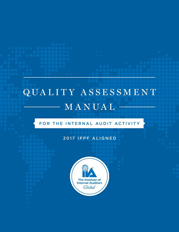Quality Assessment Manual
Trust the Quality Experts
Quality Assessment Manual for the Internal Audit Activity
The new Quality Assessment Manual for the Internal Audit Activity published by the Internal Audit Foundation in 2017, responds to issuance of The IIA’s International Standards for the Professional Practice of Internal Auditing (Standards), the related changes in the internal audit profession, and the increasingly demanding business environments in which the profession operates.
In accordance with The IIA's Standards, "The chief audit executive must develop and maintain a quality assurance and improvement program that covers all aspects of the internal audit activity" (Standard 1300). The Manual was designed to provide guidance and step by step modules for the chief audit executive (CAE) in establishing and maintaining a quality assurance and improvement program, as well as for assessors, internal and external, in testing and assessing that program. The current edition updates and expands that guidance and enhances the models and assessment tools.
The latest edition now has five chapters based on the principal elements of the quality program required by the Standards, with a continued strong emphasis on external assessments, as summarized below:
Chapter 1 – The Framework for Quality Assurance
This chapter provides an overview of the Standards and the other elements that make up the International Professional Practices Framework (IPPF). It explains how they have evolved as the profession has matured and how their application should be tailored to each organization without compromising conformance with the Standards. In particular, it presents and discusses the 1300 series of Standards that deals specifically with quality assurance.
Chapter 2 – Establishing a Quality Assurance and Improvement Program
Chapter 2 discusses the building of an effective Quality Assurance and Improvement Program (QAIP). Delivering quality requires a systematic and disciplined approach as professionals — quality does not just happen. It is the combination of the right people, the right systems, and a commitment to excellence where products and services are analyzed to verify they meet stakeholder expectations, operations are evaluated to determine their efficiency and effectiveness, and practices are assessed to confirm their conformance to standards.
Chapter 3 – Internal Assessments
This newly added chapter outlines the requirements for performing internal assessments, which are required by IIA Standard 1311: Internal Assessments annually. Processes and procedures from the Manual used to support external assessments might also be used for periodic internal self-assessment purposes. These also might be used to evaluate quality for individual engagements as a component of ongoing monitoring.
Chapter 4 – Full External Assessments
Chapter 4 addresses the external assessment requirement that an internal audit activity must have conducted at least once every five years by a qualified, independent assessor or assessment team from outside the organization. The objective of the external assessment is to evaluate an internal audit activity’s conformance with the Standards and the Code of Ethics. External assessments may also focus on identifying opportunities to enhance internal audit processes, offering suggestions to improve the effectiveness of the internal audit activity, promoting ideas to enhance the activity’s image and credibility, and offering operational or strategic comments.
Chapter 5 – Self-assessment with Independent Validation
This chapter provides guidance on using the Manual programs to conduct a self-assessment with independent external validation (SAIV), which also meets the requirements of IIA Standard 1312: External Assessments. The SAIV includes a comprehensive and fully docu¬mented self-assessment process that requires the CAE to complete the self-assessment work performed with the same level of due professional care found in performing other internal audit engagements. The independent external validation team validates the work of the internal assessment team through review of assessment planning documentation, re-performing a sample of assessment work program steps, conducting interviews with key stakeholders, and assessing the conformance conclusions reported by the internal assessment team.

Purchase this manual from the IIA Bookstore.